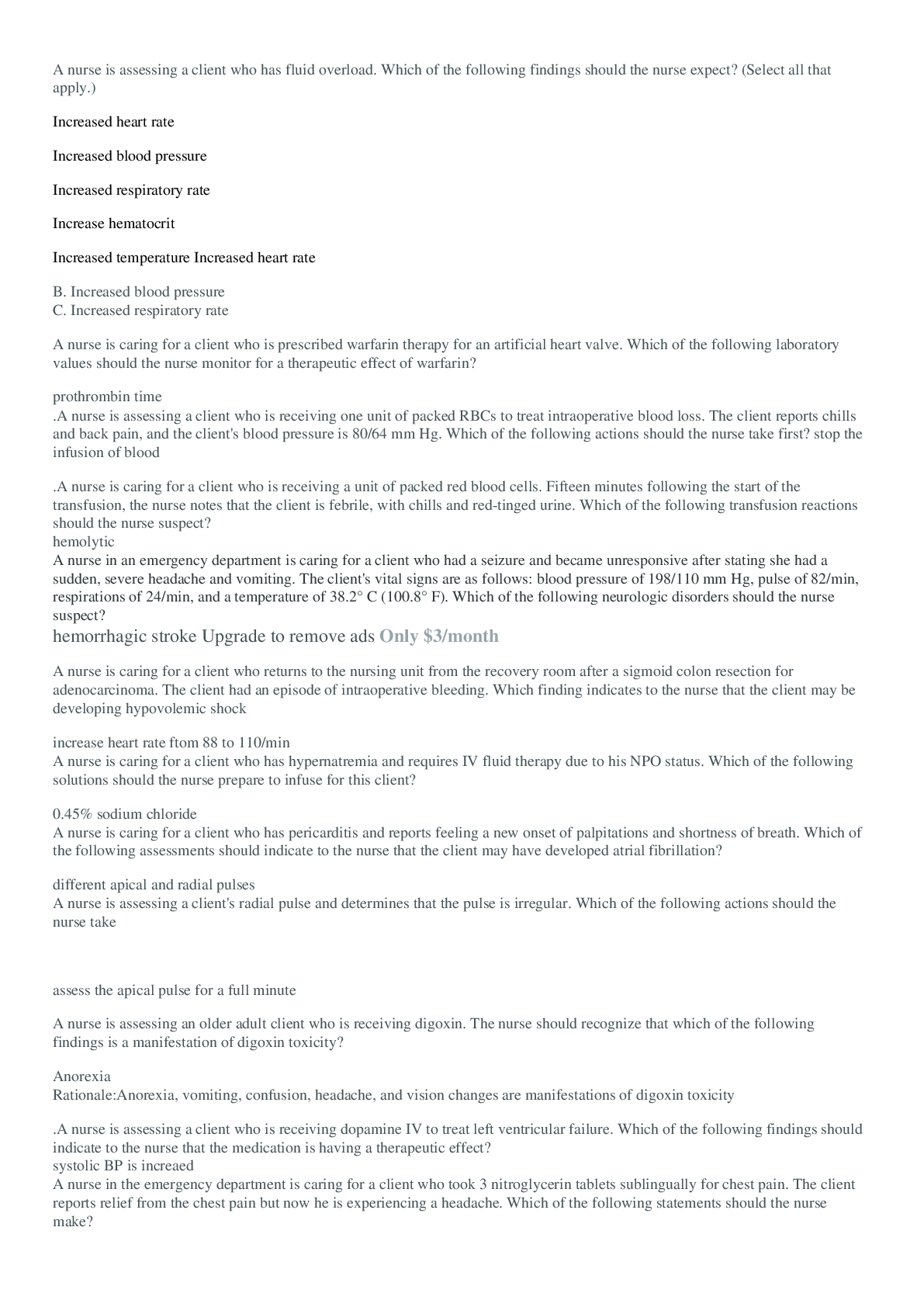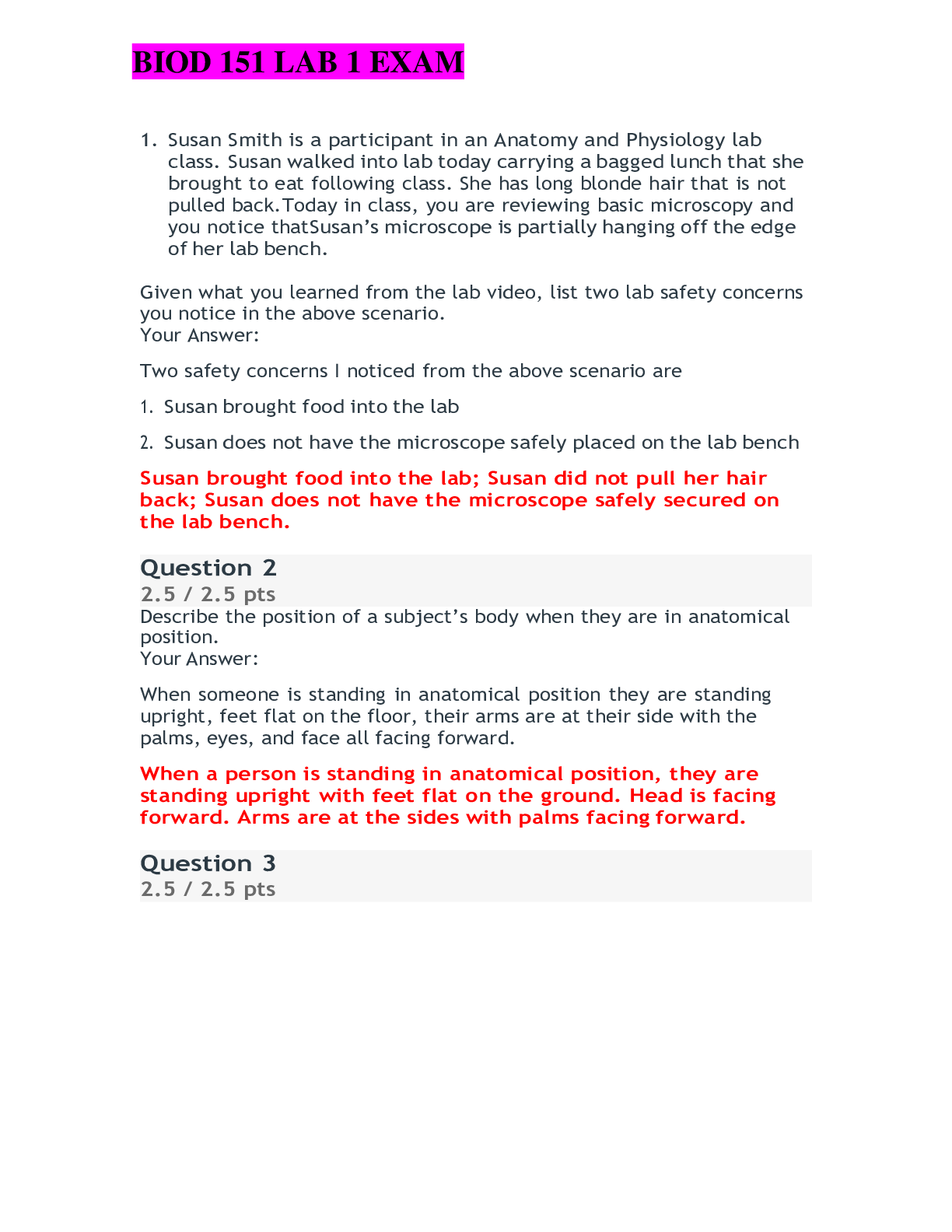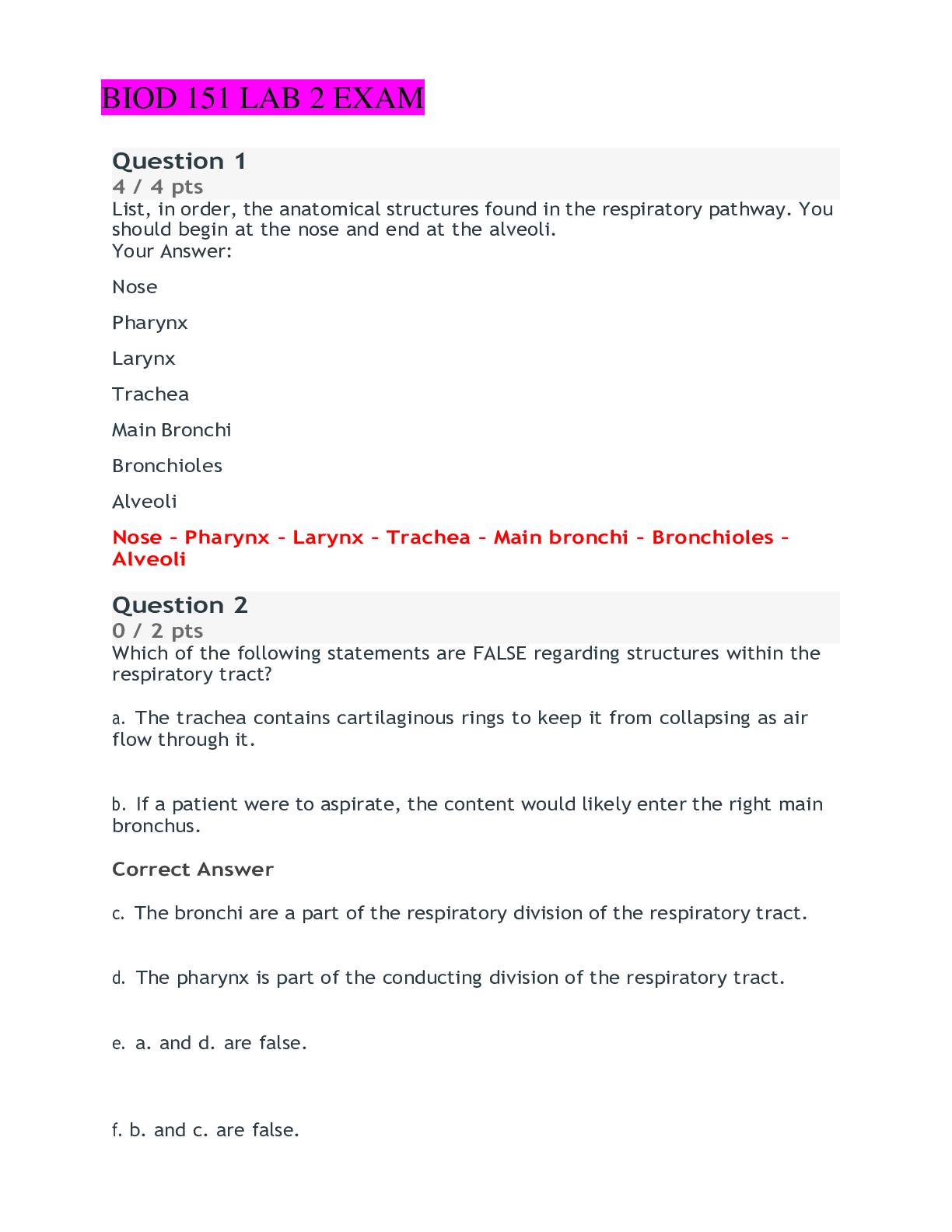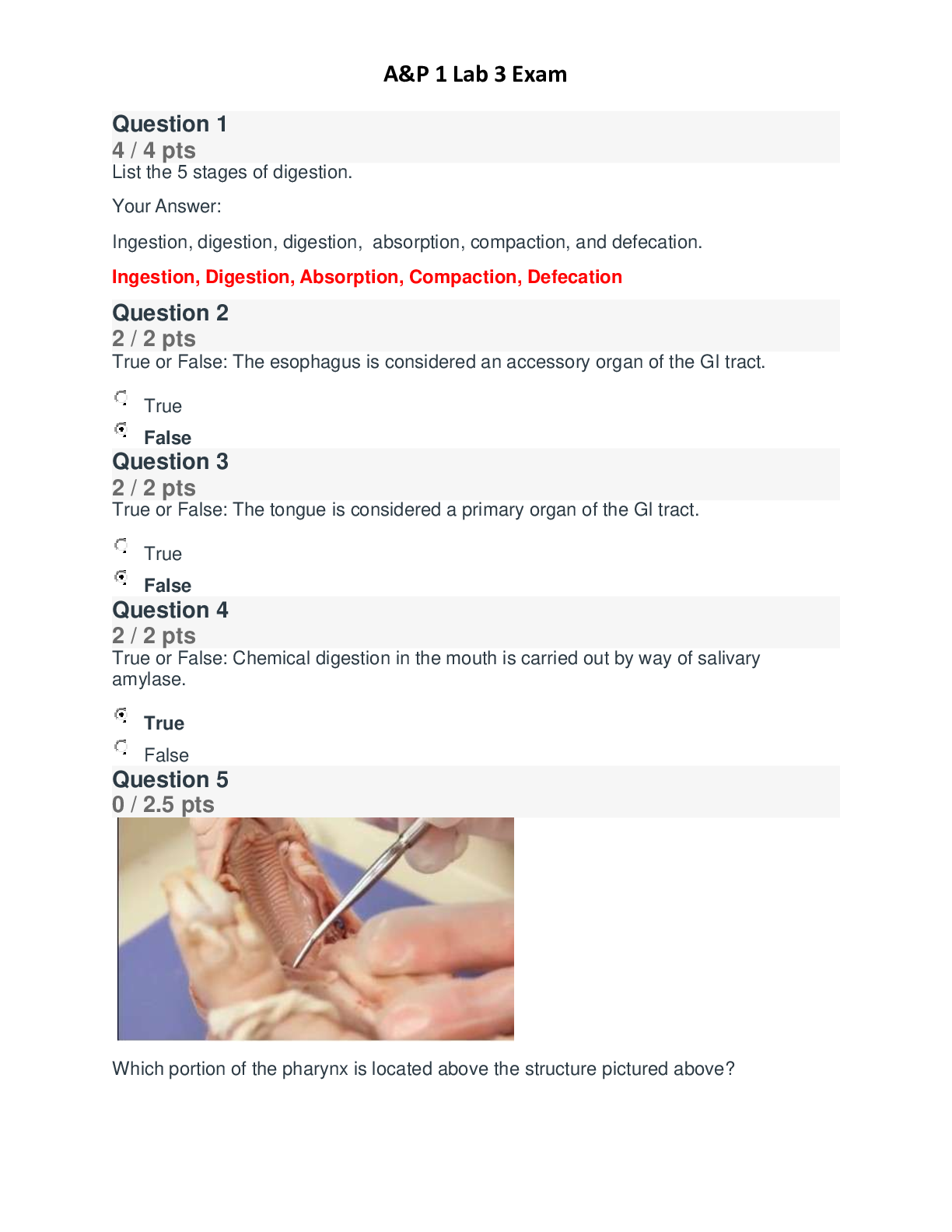Micro Biology > QUESTIONS & ANSWERS > Portage Microbiology Module 2 Questions and Answers Rated A+ (All)
Portage Microbiology Module 2 Questions and Answers Rated A+
Document Content and Description Below
Portage Microbiology Module 2 Questions and Answers Rated A+ cellular metabolism ✔✔a controlled set of biochemical reactions that occur in living organisms in order to maintain life enzyme ✔... ✔a protein, or group of proteins, that catalyze (speed up) chemical reactions/is not consumed during the reaction and can be used repeatedly by the cell cofactor ✔✔a small chemical component, usually metal ions, that assist enzymes during the catalysis reactions/serve as regulators of chemical reactions: in their absence, enzymes are inactive while in its presence enzymes are active catabolism ✔✔the process of breaking down larger molecules into useful energy sources anabolism ✔✔the building up or biosynthesis of macromolecules from smaller molecular units into larger complexes anabolism ✔✔used during growth and repair phases of the cell ATP ✔✔most widely used form of energy in the cells donate/accept ✔✔ATP has energy to _________ while ADP can ___________ energy (phosphate group) to become ATP phototrophs ✔✔acquire energy from photons of light to generate ATP from ADP chemotrophs ✔✔acquire energy from preformed (already existing) chemicals found in the environment organotrophs ✔✔removing electrons from organic molecules such as glucose lithotrophs ✔✔remove electrons from inorganic molecules such as elemental sulfur carbon ✔✔in order to carry out metabolic processes, microbes must also have a source of... heterotroph ✔✔a microorganism that derives its carbon from organic molecules such as sugars autotroph ✔✔organisms that derive their carbon from inorganic molecules, most often from carbon dioxide (CO2) phosphorylation ✔✔the addition of a phosphate group photophosphorylation ✔✔light energy is used to power the formation of ATP from ADP substrate-level phosphorylation ✔✔the phosphoryl (PO3) group of a chemical compound is transferred and donated (added) directly to ADP phosphorylated reactive intermediate ✔✔in substrate-level phosphorylation, the chemical compound losing the phosphate group is referred to as the... oxidative phosphorylation ✔✔used by chemotrophs, the energy released by the chemical oxidation of nutrients is used to reform ATP glycolysis ✔✔the breakdown of a single molecule of glucose reactants ✔✔molecules present and involved at the beginning of a chemical reaction 2NAD/2ATP ✔✔reactants with glucose in glycolysis phosphorylation of glucose ✔✔prevents glucose from diffusing out of the cell as well serving as the signal molecule to the cell that glycolysis is about to begin products of glycolysis ✔✔2 pyruvate molecules, 2 NADH molecules and 4 ATP NAD/NADH ✔✔plays a vital role in generating and maintaining energy for the cell fermentation/respiration ✔✔two main strategies utilized by cells to replenish the supply of NAD+ fermentation ✔✔an anaerobic process in which NADH is converted back to NAD+ while pyruvate is converted to a waste byproduct, commonly lactic acid or ethanol, to be eliminated from the cell respiration ✔✔a more efficient aerobic process used by microorganisms to produce energy tricarboxylic acid (TCA) cycle ✔✔central pathway of respiration/requires an additional coenzyme similar to NAD called flavin adenine dinucleotide (FAD) products of TCA ✔✔2 ATP in total (one for each pyruvate processed) and an abundance of reduced electron carriers: NADH and FADH2 primary function of the TCA cycle ✔✔production of these reduced electron carriers (NADH and FADH2)/the transfer of these electrons will fuel the generation of ATP via the electron transport system electron transport chain ✔✔a continuation of cellular respiration and can proceed either aerobically or anaerobically anaerobic respiration ✔✔less efficient and yields fewer ATP molecules than aerobic respiration mitochondria ✔✔as electrons are transferred from NADH/FADH2 to terminal electron acceptors (O2; aerobic respiration), energy is released and captured by electron acceptor proteins located in the inner membrane of.... protons ✔✔electrons are then passed down a chain of electron acceptors (thus the name) causing ___________ (H+; positive charge) to be pumped out of the membrane, causing a strong differential across the mitochondrial membrane, proton motive force ✔✔drives H+ back through the ATP synthase complex, also located in the membrane, resulting in the production of up to 34 molecules of ATP polysaccharides ✔✔typically molecules that are too large to be transported directly across the plasma membrane. Instead microbes must secrete enzymes capable of degrading the polymer into small, more manageable subunits direct contact ✔✔________________ w/ a polysaccharide is often required by the microorganism to ensure maximal absorption proteins ✔✔must also be broken into smaller subunits or individual amino acids by enzymes protease ✔✔an enzyme that catabolizes protein amino acid ✔✔a rich source of nutrients as they are a source not only of carbon and energy but also nitrogen and sulfur lipids ✔✔rich in energy, often having many reduced carbon molecules lipase ✔✔separate the fatty acid chains from the glycerol backbone lipid backbone ✔✔processed for carbon and energy fatty acid chain ✔✔degraded via the β-oxidation pathway β-oxidation pathway ✔✔a highly efficient process that overlaps with both the TCA and electron transport chain cycles/for each lipid-derived carbon atom 48 molecules of ATP are yielded, compared to the 38 molecules of ATP produced from glucose photosynthesis ✔✔the process of capturing sunlight and converting it into the usable energy sources ATP and NADPH chloroplasts ✔✔site of photosynthesis, double membrane-enclosed organelles specific to algae and plants chlorophyll ✔✔photosynthetic pigment photophosphorylation ✔✔also known as the 'light reactions', is the process of converting light energy into chemical energy to be used by the cell in the forms of ATP and NADPH membrane ✔✔light reactions always occur in the __________________, as one of the main functions is to generate a proton concentration gradient to generate ATP, a function very similar to the electron transport systems proton motor force Calvin cycle ✔✔also referred to as the 'dark reactions', involves the ability of a microorganism to use the ATP and NADPH generated in the light reactions to convert carbon dioxide (CO2) and water (H2O) into organic carbon compounds and useful carbohydrates carbon fixation ✔✔to convert carbon dioxide (CO2) and water (H2O) into organic carbon compounds and useful carbohydrates primary function of Calvin cycle ✔✔to produce the three-carbon compound glyceraldehyde 3- phosphate (G3P), which, through a series of steps, eventually leads to the generation of glucose end byproducts ✔✔__________________ of the Calvin cycle supplies the molecules required during the light reactions, just as the end products of the light reactions enables the dark reactions to occur [Show More]
Last updated: 1 year ago
Preview 1 out of 7 pages
.png)
Buy this document to get the full access instantly
Instant Download Access after purchase
Add to cartInstant download
We Accept:

Also available in bundle (1)
.png)
PORTAGE LEARNING MICROBIOLOGY BUNDLED EXAMS QUESTIONS AND ANSWERS WITH VERIFIED SOLUTIONS
PORTAGE LEARNING MICROBIOLOGY BUNDLED EXAMS QUESTIONS AND ANSWERS WITH VERIFIED SOLUTIONS
By Nutmegs 1 year ago
$20
18
Reviews( 0 )
$8.00
Document information
Connected school, study & course
About the document
Uploaded On
Sep 23, 2022
Number of pages
7
Written in
Additional information
This document has been written for:
Uploaded
Sep 23, 2022
Downloads
0
Views
92

.png)
.png)
.png)
.png)
.png)
.png)
.png)
.png)
.png)
.png)
.png)

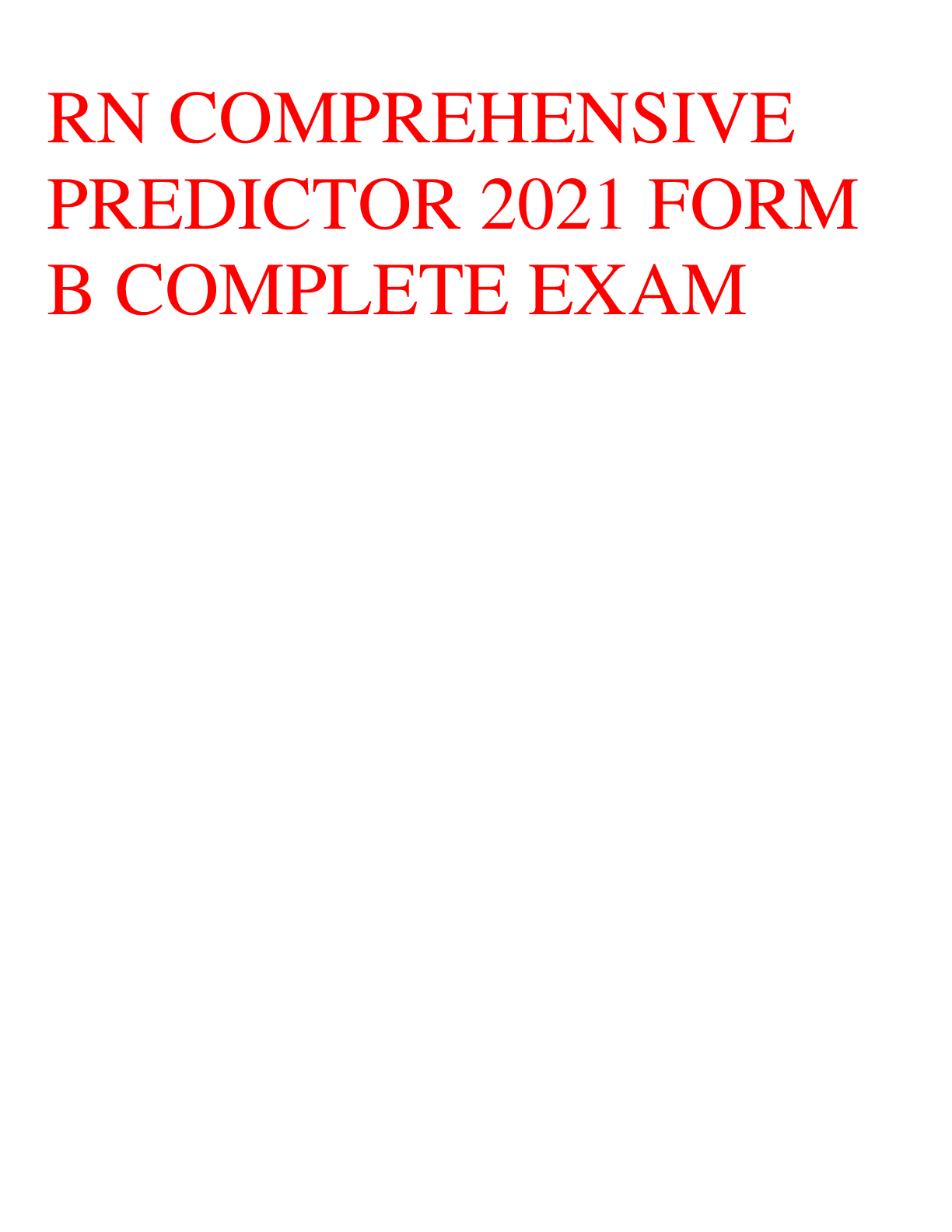

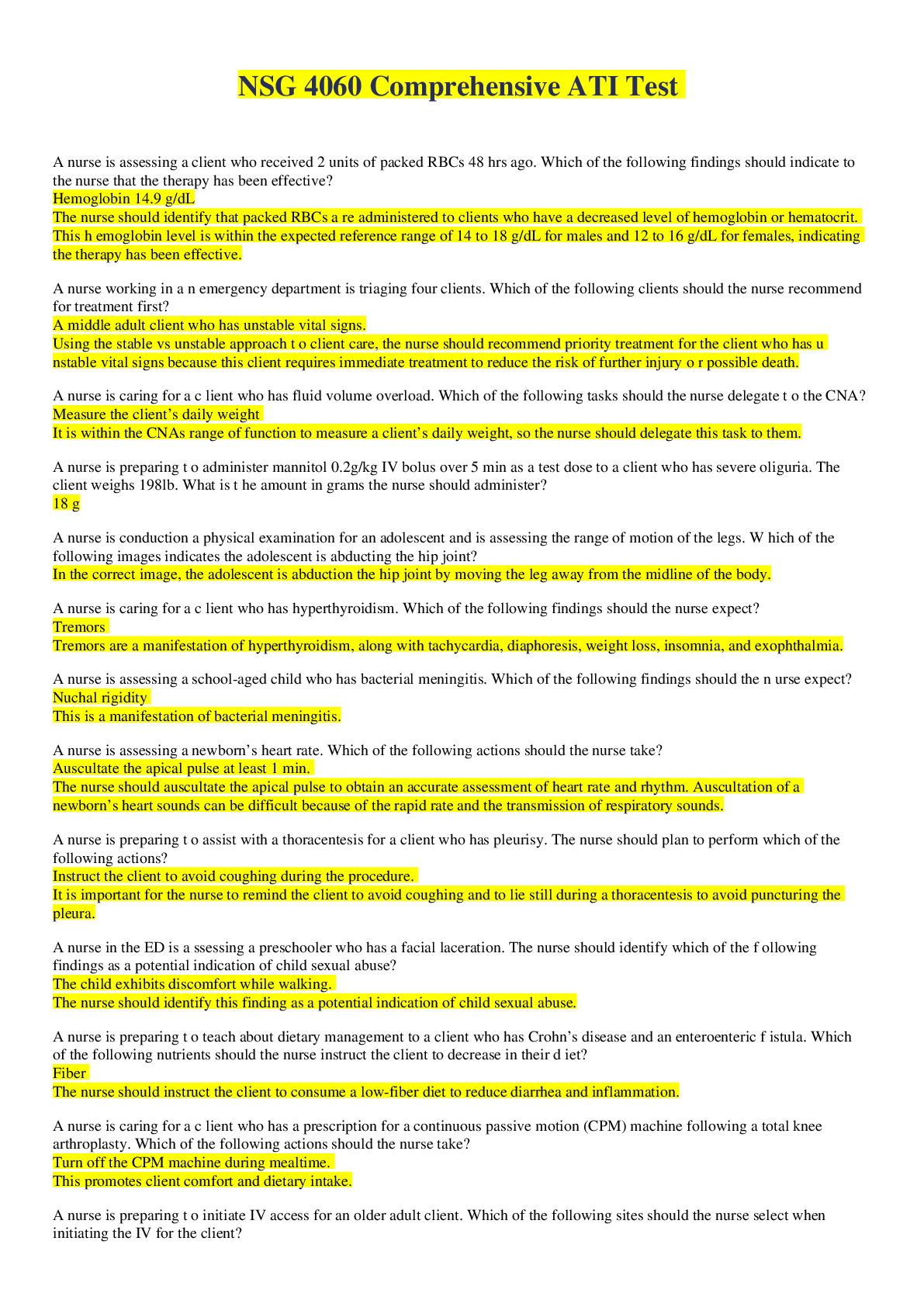

.png)
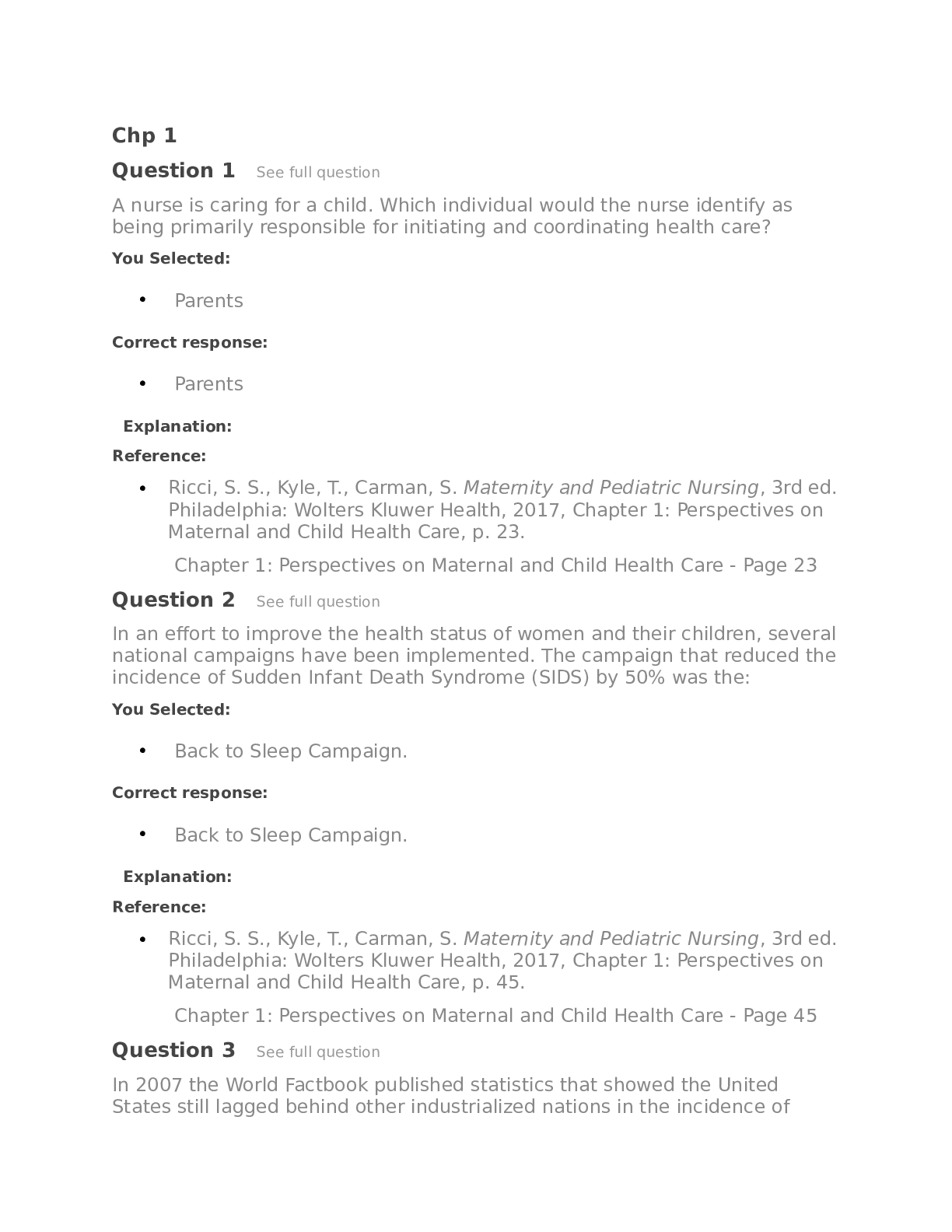

.png)
